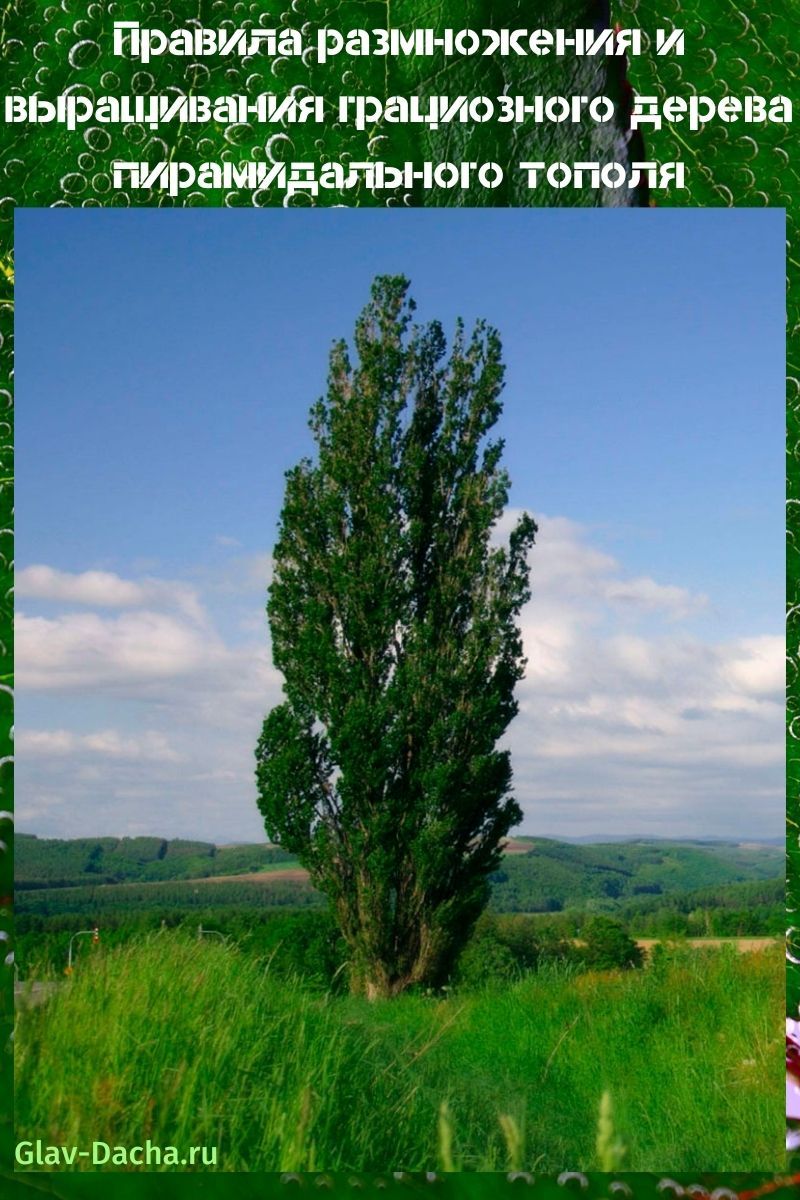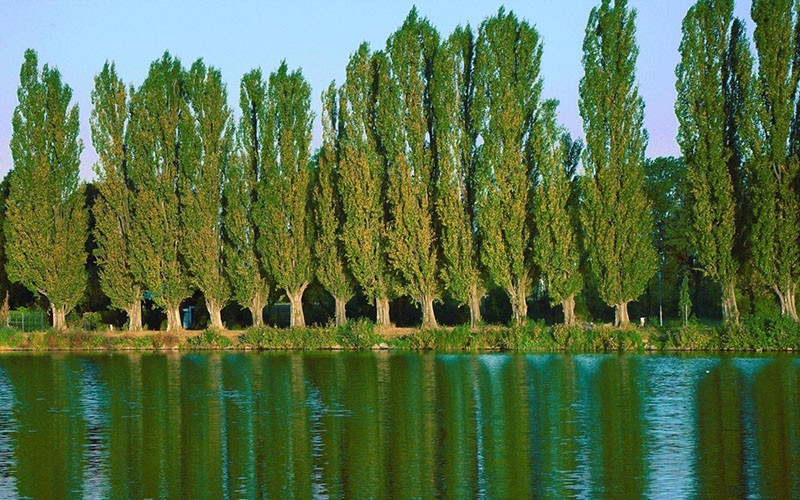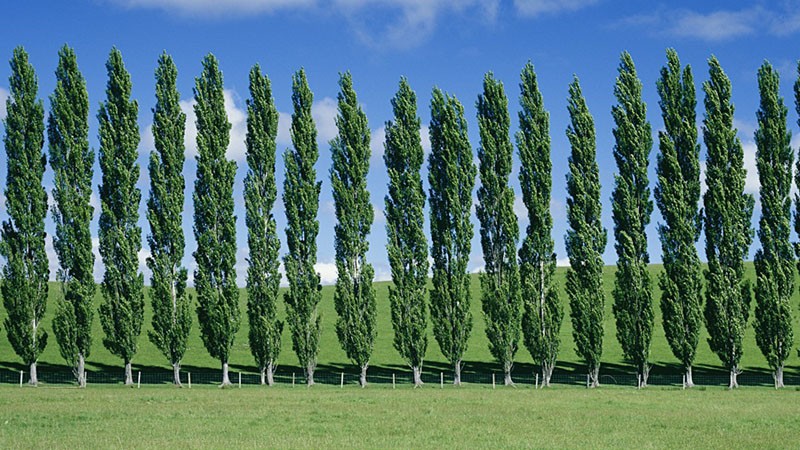Rules for the reproduction and cultivation of a graceful pyramidal poplar tree
 The pyramidal poplar is one of the most common trees in Russia, which can be seen almost everywhere. It can be seen in parks, squares, in the steppes and along highways. Due to its decorative appeal and noble appearance, the pyramidal poplar is often used in the field of landscape design - for landscaping garden plots and park areas.
The pyramidal poplar is one of the most common trees in Russia, which can be seen almost everywhere. It can be seen in parks, squares, in the steppes and along highways. Due to its decorative appeal and noble appearance, the pyramidal poplar is often used in the field of landscape design - for landscaping garden plots and park areas.
Description of the pyramidal poplar

Description of the pyramidal poplar:
- The root system is powerful, up to 1/3 of the tree height. Some roots may protrude above the ground.
- The tree can have a columnar or narrow-pyramidal crown, which can reach 3-5 m in diameter.
- The trunk of a poplar is covered with a smooth bark of a grayish-greenish shade with a glossy sheen. With age, multiple cracks appear on the bark.
- The branches of the tree grow upward, leaning to the sides.
- The leaves are rich green, diamond-shaped, with jagged edges. The leaf plates are attached to the shoots with short petioles.
- The flowering period begins in April. Earring-shaped inflorescences are divided into male and female. The former are red, the latter white. In early June, fruits are formed - elongated "boxes" with seeds covered with a fleecy down.
- Poplar pyramid has a very fast growth rate, especially during the first 10 years after planting. The top of the tree should be pruned every year.
- The average lifespan of a pyramidal poplar is 280-300 years.

The pruning height of poplar directly affects the growth of the tree. Under natural conditions, it can reach 40-50 m, but most often it is cut to a height of no more than 10 m.
Pyramidal poplar - growing rules
 Planting a pyramidal poplar requires compliance with some of the features of this culture. The tree prefers soils with neutral or weak acidity, containing garden sod, sand or peat.
Planting a pyramidal poplar requires compliance with some of the features of this culture. The tree prefers soils with neutral or weak acidity, containing garden sod, sand or peat.
Heavy, clayey soils are not suitable for growing poplar - in such conditions the seedling will grow and develop very slowly. The pyramidal poplar is highly frost-resistant, but does not “like” excessive dryness and moisture of the soil.
Before planting a pyramidal poplar, you need to prepare a suitable site. It should be with a low groundwater table and well lit, because it is sunlight that stimulates the growth of a young tree. Poplar has a strong root system that can damage foundation, therefore, the tree must be planted at a distance of at least 40-50 m from buildings.
Poplar can be propagated in several ways - by cuttings, root shoots, and seeds.
Reproduction by shoots
 Propagation of pyramidal poplar by cuttings is one of the fastest and easiest ways. Cuttings root quickly both in water and in moist soil. To reproduce a tree in this way, it is necessary to prepare poplar shoots in early spring, before the leaves bloom.
Propagation of pyramidal poplar by cuttings is one of the fastest and easiest ways. Cuttings root quickly both in water and in moist soil. To reproduce a tree in this way, it is necessary to prepare poplar shoots in early spring, before the leaves bloom.
In the summer months, grafting of the pyramidal poplar is not carried out.
How a poplar stalk develops in water depends on its age. It is best to use annual shoots for reproduction. They can be identified by their appearance - they are thin shoots at the ends of large and powerful branches. They can also be located at the top of the trunk. Their length is usually up to 20-30 cm.
How to grow a poplar from a branch:
- Divide the cut shoots into small cuttings no more than 15 cm long. Make sure that 3-5 live buds remain on each shoot.
- You cannot use cuttings with already blossoming leaves - they are less viable and take root for a long time.
- Plant the twigs into moist soil, top side up, leaving about 40-50 cm between them.
- Above the surface of the soil, at least ¼ of the length of the cutting with a pair of live buds should remain.
- Make sure that the stem is perfectly vertical, but not on the ground.
- If the soil is dense, first make small planting holes and slightly deepen the cuttings.
 After planting, cuttings need to be watered regularly. When young seedlings reach 15-20 cm, abundant watering stops and moistens the poplar only when the heat is intense and the soil dries out.
After planting, cuttings need to be watered regularly. When young seedlings reach 15-20 cm, abundant watering stops and moistens the poplar only when the heat is intense and the soil dries out.
Seed propagation
 One way to propagate pyramidal poplar is by using seeds. They can be collected from the ground, as the seeds are carried by the wind along with the fluff. They can also be plucked directly from the tree when the seed pods begin to open.
One way to propagate pyramidal poplar is by using seeds. They can be collected from the ground, as the seeds are carried by the wind along with the fluff. They can also be plucked directly from the tree when the seed pods begin to open.
The collected seeds must be sown as quickly as possible, since they remain viable for only a few days.
Seed sowing rules:
- Prepare the site - level it with a rake, then spread the collected seed pods on the ground surface.
- They can be placed both evenly throughout the entire site, and in even rows.
- Pour the pyramidal poplar seeds from the watering can - they will go deeper into the ground with the water.
- Seeds should not be covered with soil - they should be left on its surface.
- Seeds need to be watered regularly. The soil must be well moistened, it must not be allowed to dry out.
- For better rooting of seeds, it is best to cover them with plastic wrap or other covering material for 3-4 days.
Seedlings appear very quickly - after 8-10 days. After the seedlings reach a height of 5-7 cm, thin them out, leaving a distance of about 10-15 cm between the seedlings. Using this method, by September you can get strong and viable seedlings, ready for transplantation to a permanent place.
Pyramidal poplar care
 The pyramidal poplar does not present any difficulties in care. It is enough to water the tree every 4-6 weeks, in dry and hot weather. In a rainy summer, you can do without additional watering.
The pyramidal poplar does not present any difficulties in care. It is enough to water the tree every 4-6 weeks, in dry and hot weather. In a rainy summer, you can do without additional watering.
It is necessary to loosen the soil for the first 5-7 years, after which it is best to sow the near-trunk circle with lawn grass. Pruning is an important part of caring for a pyramidal poplar. During the procedure, you need to shorten about half the length of the branches, leaving about 15-20 cm.
When pruning, you need to give the poplar crown a neat, attractive shape. The crown should remain neat and even, no shoots should stick out of it. The frequency of pruning pyramidal poplar depends on how fast it grows - young trees may require more frequent crown formation.
Pyramidal poplar is a graceful and majestic tree, which is widely used for landscaping personal plots and park areas. It creates original and colorful compositions with conifers, chestnuts, acacias, maple and ornamental varieties of juniper. Growing a pyramidal poplar is not particularly difficult, but it has some nuances. Given these features, you can get the perfect decoration for your garden.